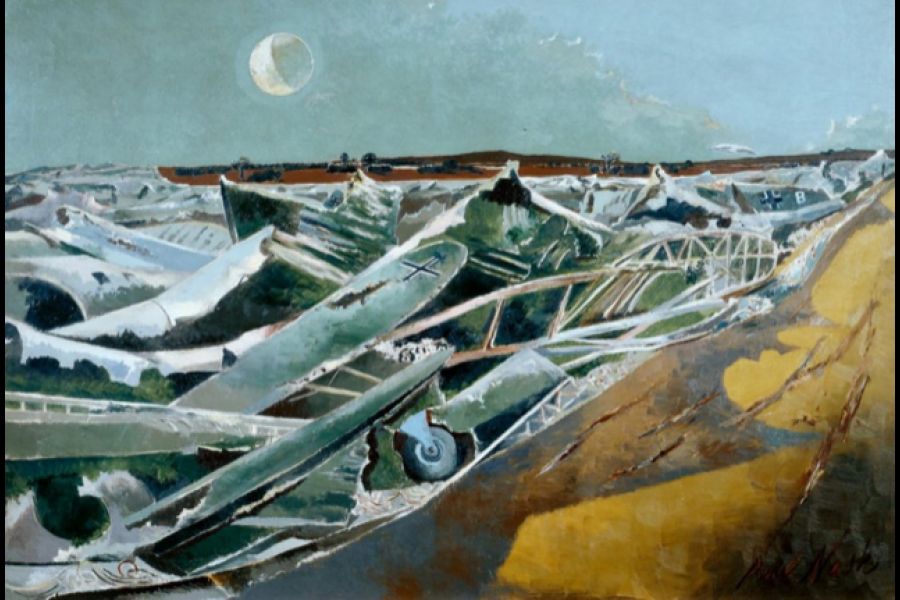What do the words "spirit of place" mean to us?
Do we think of a home left long ago or a new place where we instantly feel we belong? Perhaps it’s a place of shallow frivolity or conversely, a mysterious place that entices or even demands that we probe what lies beneath the surface?
This idea of place, this location, be it physical or psychological and this idea of spirit, be it subjective or emotional, lies beneath the work of Paul Nash, one of the most significant artists of the first half of the 20th century.
Nash was born in London in 1889 and died in 1946 in Boscombe, Dorset. He was a Surrealist painter, war artist, photographer, writer, wood engraver and designer of applied art.
He was key to the development of Modernism in English art. His passion for nature and landscape gave his earlier works a romantic mystical quality that would change with his later symbolic landscapes of the shattered battlefields of the two world wars. Neither he nor his art would be the same after the trenches.
Nash studied briefly at the Slade School of Art in London. In 1914, he enlisted for Home Service with the Artists’ Rifles. He married the Oxford-educated suffragette, Margaret Odeh, and in 1916 was called up for officer training and sent to the Western Front.
The night of May 25, 1917, 2nd Lt. Nash of the Hampshire Regiment, based on the Ypres Salient in Belgium, fell into a trench, broke a rib and was sent back to London. A few days later, most of his unit were killed in a surprise assault on their position, Hill 60.
In six months, Nash returned to Ypres as an official war artist. The landscape, which in the spring had shown signs of recovery, was now destroyed by constant shellfire, heavy bombardment and relentless rain.
In despair and anger, Nash wrote to his wife, “It is unspeakable, godless, hopeless. I am no longer an artist interested and curious. I am a messenger who will bring back word from the men who are fighting to those who want the war to go on forever. Feeble, inarticulate, will be my message, but it will have a bitter truth, and may it burn their lousy souls.”
Nash did “50 drawings of muddy places,” which were worked into some of the most famous paintings of the war, "We Are Making a New World," "The Ypres Salient at Night" and "The Menin Road," all exhibited to critical acclaim at "The Void of War" exhibition in London in 1918.
In these works, the composition does not move forward to the viewers, we are drawn in, pulled in, to contemplate and witness. In "We are Making a New World," what new world? It’s a mockery.
This is a nightmarish world of the death of nature with forlorn dismembered trees equivalent to human carnage, convulsed land and craters faintly illuminated by a cold white sun, devoid of warmth. And, although we do not see the bodies, we know they are there. And we know the craters are also the result of digging tunnels beneath the enemy in order to blow them to kingdom come.
By 1921, Nash was mentally and physically exhausted, suffering what we now casually refer to as PTSD. He kept working and in 1933 co-founded with fellow artists Henry Moore, Stanley Spencer, Ben Nicholson, Barbara Hepworth and critic Herbert Read, the short-lived modern art movement, Unit One, with a goal to achieve “the expression of a truly contemporary spirit."
With the outbreak of the Second World War, suffering from asthma and too ill to fight, Nash served again as a war artist attached to the Royal Air Force and the air ministry.
He created "The Battle of Britain l941" representing the aerial battle of the young RAF fighter pilots against the oncoming ranks of Luftwaffe bombers over the Thames Estuary and the English Channel.
His masterwork, "Totes Meer" (Dead Sea), is a war-torn landscape of mangled machine parts of shot down German planes hauled to the Cowley dump near Oxford.
Symbols of the Luftwaffe appear in the turbulent jumble of wings and wheels that seem to wash and subside like waves bearing the dreams of war, the lure of adventure and the joy and freedom of flight for pilots too young to die. A white owl, symbolic of the spirit in flight, lifts and flies away to the horizon.
Nash died in his sleep of heart failure on July 11, 1946. He was 57.
Penny-Lynn Cookson is an art historian who taught at the University of Toronto for 10 years. She was also head of extension services at the Art Gallery of Ontario. Watch for her upcoming lectures at the Niagara Pumphouse Arts Centre and at RiverBrink Art Museum in Queenston.










